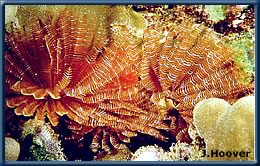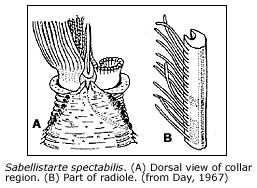

Chaetopterus sp.

Sabellestarte spectabilis

Salmacina dysteri
Sabellastarte spectabilis
 Featherduster
worm, Fan worm
Featherduster
worm, Fan worm
Phylum Annelida
Class Polychaeta
Family Sabellidae
Description
This large species attains 80 mm or more in length and 10 to 12 mm in
width. The entire body of the worm is buff colored with flecks of purple
pigment. These worms inhabit tough, leathery tubes covered with fine mud.
Radioles (branched tentacles) lack stylodes (small finger-like projections
on the tentacles of some sabellids) and eyespots and are patterned with
dark brown and buff bands. There is a pair of long, slender palps and
a 4-lobed collar. These worms are very conspicuous on reef flats and harbor
structures because of their large size and banded pattern of the branchial
crowns (from Bailey-Brock 1987).
Habitat
 Abundant
on Oahu's south shore reefs, and in Pearl Harbor and Kaneohe Bay at shallow
depths, especially in dredged areas that receive silt-laden waters. Also
found in pockets and crevices in the reef flat. It is especially abundant
along the edges of reefs that have been dredged, as at Ala Moana and Fort
Kamehameha, Oahu; it may be an indicator of waters with high sediment
content (Bailey-Brock 1976). Reported from a wide variety of coastal habitats
(e.g., in holes, crevices, and matted algae at outer reef edges of rocky
shores, from interstices of the coral Pocillopora meandrina; from under
boulders in quiet water, in crevices in lava, in open coast tide pools,
and from tidal channels exposed to heavy surf).
Abundant
on Oahu's south shore reefs, and in Pearl Harbor and Kaneohe Bay at shallow
depths, especially in dredged areas that receive silt-laden waters. Also
found in pockets and crevices in the reef flat. It is especially abundant
along the edges of reefs that have been dredged, as at Ala Moana and Fort
Kamehameha, Oahu; it may be an indicator of waters with high sediment
content (Bailey-Brock 1976). Reported from a wide variety of coastal habitats
(e.g., in holes, crevices, and matted algae at outer reef edges of rocky
shores, from interstices of the coral Pocillopora meandrina; from under
boulders in quiet water, in crevices in lava, in open coast tide pools,
and from tidal channels exposed to heavy surf).
Distribution
Hawaiian Islands
Shallow water throughout main islands
Native Range
Red Sea and Indo-Pacific
Present Distribution
Western Africa, Red Sea, India, Indo-Pacific, Japan, New Caledonia, Hawaiian
Islands
Mechanism of Introduction
Unintentional, probably as fouling on ships hull.
Impact
Fouling organism and popular aquarium species. Ecological impact unstudied,
but most likely minimal.
Ecology
Feeding
Sabellids are suspension feeders. Cilia on the tentacles create a current
that draws water and food particles to the worm. The particles are captured,
sorted, and carried with mucus along a series of tracts and grooves to
the mouth. Large particles are stored for use in tube building.
Reproduction
Sabellid worms can reproduce asexually by fragmentation, and can also
regenerate lost body parts, including the large branchial crown. These
worms are dioecious (having separate sexes). Gametes arise from proliferation
of cells from the peritoneum, these cells are released into the coelom
where they mature, before being released. Fertilization is external, and
after a short time in the plankton, the trochophore larva settles and
matures.
Remarks
This large and distinctive sabellid, has had a complex taxonomic history.
It is not noted in the Hawaiian biota until after World War II. There
is no material in Bishop Museum collections prior to 1946, nor is there
any mention of it in the literature until 1966. It does not appear (either
by name or by description) in Edmondson's books (1933, 1946), nor is it
mentioned in the early fouling studies of Pearl Harbor, an environment
with which Edmondson was very familiar.
On the assumption that such a large fouling species would not be overlooked,
we treat it here as introduced. Since 1966, it has been treated in the
Hawaiian literature as Sabellastarte sanctijosephi
, a species originally described from the Red Sea and regarded as occurring
from western Africa to the Indo-Pacific and up to Japan (Day 1967). Hartman
(1966) also synonymized S. punctata under
S. sanctijosephi, the former species having
been collected during the Albatross expedition in 1902 at Puata Bay and
Waialea, Oahu (Hartman, 1966, as S. indica).
Hartman (1966) noted that R. W. Hiatt collected it in 1946 at Halape,
Hawaii, from a wide variety of coastal habitats. It has since been widely
reported throughout the main islands.
Knight-Jones (pers. comm.) has revised the taxonomy of this worm as shown
above, assigning the name S. spectabilis
(originally described from the Philippines) to the large Hawaiian worm
and resurrecting S. punctata as a distinct,
smaller species. With this resolution, the 1902 records dissolve; in addition,
it is not clear which of the above records - which range from harbor fouling
habitats to open coast reef sites - would be reassignable to which species.
We tentatively interpret the harbor and dredged channel populations, at
least, to represent S. spectabilis.
References
Bailey-Brock, J.H. 1976. Habitats of tubicolous polychaetes from the Hawaiian
Islands. Pacific Science. 30:69-81.
Bailey-Brock, J.H. 1987. Phylum Annelida. in: Reef and Shore Fauna of
Hawaii, Section 2: Platyhelminthes through Phoronida and Section 3: Sipuncula
through Annelida, D.M. Devaney and L.G. Eldredge, eds. Bishop Mus. Spec.
Pub. 64(1 and 3): 216-454.
Day, J.H. 1967. A monograph of the Polychaeta of Southern Africa. Part
1 and 2. British Mus. Nat. Hist, London.
Edmondson, C.H. 1933. Reef and Shore Fauna of Hawaii. B.P. Bishop Mus.
Spec. Pub. 22.
Edmondson, C.H. 1946. Reef and Shore Fauna of Hawaii, 2nd ed. B.P. Bishop
Mus. Spec. Pub. 22.
Hartman, O. 1966. Polychaetous annelids of the Hawaiian Islands. Occ.
Pap. B.P. Bishop Mus. 33(11): 163-252.
© 2002 Hawaii Biological Survey, Bishop Museum
contact